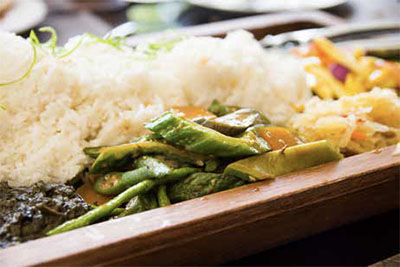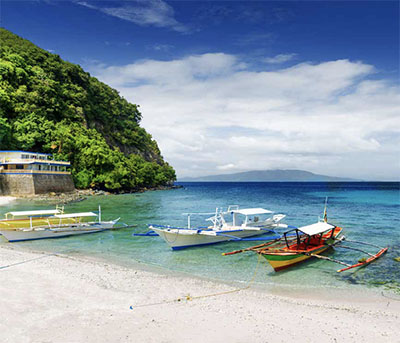LUZON MAY BE DOMINATED by the bustling capital city, Manila, but there’s another unique location on the largest of the Philippine archipelago’s 7,500 islands. Vigan, the country’s only UNESCO World Heritage site, lies 250 miles north along the west coast, facing the South China Sea. A visit to its cobblestone streets and Philippine/Oriental fusion architecture offers an opportunity to experience the historic charm of one of the best-preserved Spanish colonial towns in Asia.
Now part of the mainland as a result of silting in the Mestizo River, originally the city was an island settled by early Chinese immigrants who developed a major Silk Route port. They called it “Beautiful Shore,” or Bee Gan, a pronunciation corrupted by the Spanish who arrived in 1572 to take over the thriving post trading gold, timber and beeswax. Known then as Villa Fernandina in honor of a Spanish prince, its vivid history evolved during the mid-17th century into a hotbed of dissent against the Spanish overlords who assassinated revolutionary Diego Silang and publicly hanged his wife and successor, Gabriela. During World War II, the arrival of the Japanese Army escaping American bombers spared the city from destruction. Today, its three interconnected main squares preserve the ambience of colonial times.
With a population of just more than 50,000 and few automobiles, the compact city is easy to explore on foot, by horse carriage and tricycles. Fleets of horse-drawn kalesas clip-clop through the city, charging only about 150 pesos ($3.50) per hour. Less nostalgic but faster and more efficient are tricycle taxis — sidecar motorcycles that whiz passengers anywhere in town for less than a quarter.
Following the customary Spanish “Law of the Indies” town plan (a grid anchored by a central plaza or park), Vigan grew up around Plaza Salcedo, today dominated by a pool surrounded by religious and administrative buildings: the Casa Real and Municipal Hall and the Bishop’s Palace beside massive, thick-walled St. Paul’s Cathedral, named for the city’s patron saint, St. Paul the Apostle. Designed to survive, the church was created in the Earthquake Baroque style, low and wide with heavily buttressed side walls to withstand tremors. As a further precaution, the belfry stands beside the church, detached to avoid collapse onto the main structure. Chinese details on the brass communion handrails provide signs of the locale’s multicultural mixture and is typical of the amalgamation of Chinese, Spanish and American influences on the buildings throughout town.

Pinakbet © RECYAP8 | DREAMSTIME.COM
Right beside the cathedral — and unusual to the traditional Spanish design — a second public square, Plaza Burgos, presents a lively scene of food stalls peddling local snacks. Diners can sit at picnic tables and try arroz caldo, chicken porridge; soupy miki, noodles; ukoy, deep-fried shrimp mixed with flour and eggs; poqui-poqui, mashed eggplant and egg; and the city’s famous fluffy but crunchy empanadas. Homesick travelers can opt for a three-piece hearty meal at the picturesque “vintage-style” ochre plaster McDonald’s.
Plaza Burgos honors Padre José Burgos, the 19th-century Roman Catholic priest whose martyrdom sparked the Philippine Revolution. A few blocks west, the rambling 18th-century building that was his home now holds the Burgos Museum, where exhibited relics chronicle his life. Discouraged by the clergy’s support of harsh Spanish practices, he wrote an open letter “To the Spanish People” arguing for reform. When soldiers and workers mutinied, Padre Burgos was arrested in retaliation and executed by garrote in 1872 in Manila.
Steps away, Old Town, or the Mestizo District, comprises 24 city blocks lined with pastel-hued ancestral homes. These authentic and faithfully restored mansions, designed in a combination of Oriental and Spanish styles, boast arched windows, filigree wrought-iron trim, crenellated awnings and ventilated walls. In some, the ground floor has been converted to shops selling a plethora of souvenirs — pottery, curios, baskets, thousands of flip flops — to browsers who shop while their patient horses stand at carriages along the main thoroughfare, Crisologo Street, closed to motor traffic.
While many homes remain in private hands, a few open to the public enable visitors to get a sense of the past lifestyle. Visitors can make an appointment to see the vintage wood furniture, curios and oil paintings of the Quema House, while Syquia Mansion, former home of President Elpidio Qirino, includes a collection of presidential memorabilia. One large mansion converted into the Crisologo Museum displays everyday family artifacts as well as the trousers and sunglasses local Congressman Floro Chrisologo was wearing the day he was assassinated in 1970 while attending mass in the Cathedral.

Mindoro Island © EFIRED | DREAMSTIME.COM
Swimmers can hire a tricycle for the 15-minute ride to the black-sand expanse of Mindoro Beach. Another outlying option is the quirky 40-minute cruise on the Mestizo River. Colorful open boats covered with awnings paddle the narrow waterway while an audio guide describes five “tableaus” constructed on the bank. Life-size costumed mannequins populate the diorama scenes depicting Vigan’s history from pre-colonial times through the 1572 arrival of Juan de Salcedo and on to an elaborate exhibit celebrating the local products of trade: weapons, vinegar and fish paste.
For dining, local fare assimilates regional, Chinese and Spanish dishes. The province’s specialty Ilocano cuisine features local vegetables enhanced with sweet, sour and salty flavors. In pinakbet, bitter melon, eggplant, squash and okra are cooked with bagoong, fermented shrimp, or bagnet, sun-dried pork belly, fried crisp before it’s mixed with the vegetables. Soupy variations of pinakbet include dinengdeng, principally squash cooked with fewer vegetables, and dinoydoy, which balances the flavors of squash and bitter melon. Only the adventurous need sample pork blood-based lumo soup and the sinanglao mixture of beef broth and innards. Local sugarcane wine accompanies meals.
For a colorful conclusion to the day, enjoy the nightly fountain show. At 7:30 p.m., Plaza Salcedo lights up with sprays and spouts of water dancing to tunes ranging from the Titanic theme to the Philippine national anthem.
Philippine Islands Info to Go
Hardy travelers can opt for the drive or bus trip, a scenic six-hour ramble up Luzon’s west coast through quaint villages, past mango groves, maize drying in the sun and distant mountains. More realistic is the hour-long flight from Manila (MNL) to Laoag (LAO), the nearest airport; from there, taxis and shuttles make the 40-minute drive to Vigan. Philippine Airlines flies the route two to three times daily, and the fare costs about $150.
Where to Stay in the Philippine Islands
CORDILLERA INN Rich history and modern facilities, past and present, meet in 24 refurbished, air-conditioned, pristine white rooms with traditional wood furniture and gossamer netting looped over fourposter beds. 29 Mena Crisologo St. $$
HOTEL LUNA With laudable location, service and food, the Philippines’ only museum hotel showcases art in historic, ornately decorated whitewashed rooms overlooking an arcaded courtyard surrounding the pool. Luna Street $$
HOTEL VENETO DE VIGAN This recently renovated, centrally located, rambling white plaster edifice features a coffee shop, bar and restaurant and also offers free WiFi, airport transfers and plenty of parking spaces. Bonifacio Street $$
Restaurants in the Philippine Islands
CAFÉ BIGAA This cozy converted pub serves a Vigan sampler for diners who want to try the local bagnet and pinakbet. Vigan Plaza Hotel, Mena Crisologo Street, Plaza Burgos $$
CAFÉ LEONA Casual and conveniently located, this long-time favorite serves Philippine specialties and popular brick-oven bagnet pizza. Its outdoor tables draw an evening crowd. Mena Crisologo Street $$
LILONG & LILANG Located within the Hidden Garden two miles west of town, this Asian-inspired outdoor restaurant is a place to find authentic local Ilocano cuisine served in the ambience of tropical plants and flowers. Hidden Garden, Barangay Bulala $$
Read This Next

Introducing
FX Excursions
FX Excursions offers the chance for once-in-a-lifetime experiences in destinations around the world.
#globility
Insta FeedAirlines
Jan 14, 2025Turkish Airlines Introduces UNESCO Türkiye Series Amenity Kit Collection
Turkish Airlines recently launched a new amenity kit collection, known as the UNESCO Türkiye Series. Inspired by six of Türkiye’s UNESCO World Heritage sites, the amenity kit collection allows the airline to bring the country’s cultural treasures to the skies.
Sponsored Content
Sailing the Ionian Sea: Explore Greece’s Nautical Gems
Sailing the Ionian Sea is an enchanting way to experience Greece's breathtaking islands and pristine waters. Known for its favorable winds, calm seas and stunning landscapes, the Ionian Sea offers a paradise for both experienced sailors and those looking to explore for the first time. From lively beaches to secluded bays, these waters have something for every traveler seeking adventure and relaxation.
Daily
Jan 14, 2025Costa del Sol, Spain, Doesn’t Hold Back for 2025 Travelers
With the arrival of a new year, Costa del Sol invites travelers to explore its culture, gastronomy, sustainability and wellness offerings. For those looking to disconnect from stress, immerse with nature and discover new cultures, this province of Málaga offers plenty of activities to keep up with your 2025 resolutions. Need some convincing?
Daily
Jan 14, 2025First NH-Branded Hotel Debuts in Bangkok
Minor Hotels, in partnership with Boulevard Hotel Company Limited, opens NH Bangkok Sukhumvit Boulevard hotel, the first NH Hotels & Resorts-branded property in Thailand’s capital.
Sponsored Content
Extraordinary Egypt
ONCE-IN-A-LIFETIME JOURNEY INTO THE ANCIENT WORLD OF THE PHARAOHS
Daily
Jan 13, 2025Nader Sculpture Park Opens in Miami’s Design District
The latest addition to Miami Design District is Nader Sculpture Park. Founded by art collector Gary Nader and designed by Bea Pernia of BEA Interiors Design, this park is an open- air collection of more than 50 large-scale sculptures residing within Miami’s celebrated neighborhood of fashion, design, art, architecture and dining. Pernia, distinguished by her knack for blending organic materials into expressions of elegance, also has a studio in the city’s design district.
7 Reasons to Ski in Slovenia
Daily
Jan 10, 20257 Off-the-Beaten-Path Asian Hotels
Daily
Jan 10, 2025Daily
Jan 9, 2025New Spier Hotel Launches This Spring in South Africa’s Western Cape
Lauded for its outstanding wines and regenerative farming practices, Spier Wine Farm in South Africa’s Western Cape region prepares to welcome its first guests to its new hotel this spring, with an opening planned for March. Owned by the Enthoven family, the wine estate is located within a protected area known as Cape Floral Kingdom.
Sponsored Content
United Airlines First to Purchase Sustainable Aviation Fuel for ORD
Chicago O’Hare International Airport will soon receive sustainable aviation fuel, all thanks to United Airlines, which became the first airline to purchase SAF for use at the airport, one of the largest in the United States. Neste, a producer of SAF, will provide up to 1 million gallons of its Neste MY Sustainable Aviation Fuel. The first supply arrived in August.
Daily
Jan 9, 20255 Wellness Journeys to Try at COMO Hotels & Resorts This Year
Jumpstart your 2025 wellness goals and book one (or more!) of COMO Hotels and Resorts’ COMO Wellness Journeys, held at properties around the world throughout 2025.
ShareThis